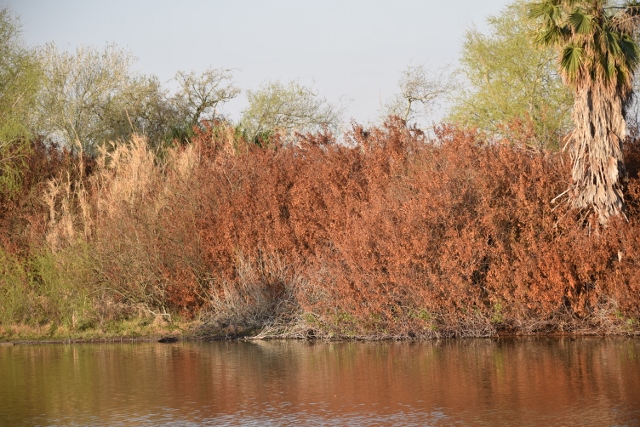
The green haze of new leaf growth on the boughs and twigs of Mexican ash and honey mesquite trees is exciting in any typical year. This year, it’s especially so. Not only does it mean winter is over, it also means plants we thought were dead have survived the brutal February freeze.
Along with the exciting signs of new life, another sight that gave my heart a momentary frisson of delight was the cinnamon color of dying leaves of Brazilian pepper trees across the resaca, the tan spires of dead-looking Arundo donax (giant cane) and dried tufts of Guinea grass — all invasive species. Unfortunately, I suspect the plants themselves are not dead.
The cold- and wind-burned palm fronds will soon dry up and hug the trunks of Washingtonian palms — that’s a good thing — great bat and bird habitat as well as living quarters for cockroaches and mice.
It’s my notion that at the end of the world cockroaches and variable leaf snailseed vine, Cocculus diversifolius, will have a continued existence. On the first day after the last freeze day, the only green in the yard seemed to be the leaves of snailseed vine — a deep rooted and prolific vine that twines around anything it finds. On its behalf, it is good bird food and a host plant for the moonseed moth.
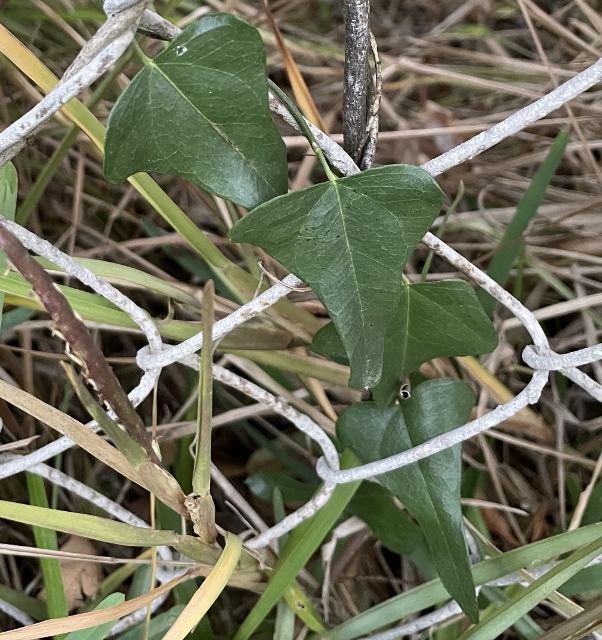
Most gardeners have too many plants to try to protect from the occasional below-freezing temperatures we experience every so many years. Even those who were able to protect plants this time weren’t prepared for the relentless icy winds and the extended length of time the Valley suffered with the dipped temps.
One of my sad losses was a four-year old tropical Dutchman’s pipe vine, Aristolochia trilobata, which is a host plant to the polydamus swallowtail butterfly. However, laziness and sloppiness may have paid off for once. In my haste one day before the freeze, I piled some palm frond fans in the garden at the courtyard wall — and left them for later removal. I’d inadvertently covered up where the vine’s runners had rooted into the soil. If all goes well, I will still have a tiny bit of the vine.
It’s still too early to tell what all has survived. Each day more shrubs and trees are showing signs of life. Leaves are budding out on the anacua, wild olive, Berlandier’s fiddlewood, Mexican Caesalpinia, Barbados cherries, Dalea scandens, lote bush, Jann Miller’s Mauve Indian Mallow and the lower twigs of Vasey’s adelia.
No signs of life yet at the potato tree, Turk’s cap and esperanza.
I’m pleased to note many plants are pushing up new growth from the ground, per normal: basketflower, frostweed, Butler’s sand parsley and sunflowers from last year’s seeds; heliotrope, zizotes, fiddle leaf tobacco rosettes, old man’s beard and non-native Mexican flame vine show new growth from the roots. No signs yet of new scarlet sage, passion vines, Passiflora foetida, Berlandier’s trumpets nor new life on the twigs of the wedelia, common balloon vine and Alamo vine.
Drop a comment and let us know what native plants are showing signs of life in your gardens so others will be on the lookout and not cut things down prematurely.
In other news, last spring, along the road near our property, I saw what looked like early spring tiny Tim plants; I stopped, took a photo, uploaded to iNaturalist. Come to find out, the plant was identified as large selenia, Selenia grandis (also called Rio Grande Valley selenia). In the comments section, the identifier left a message: “Great find!” The day after the brutal freeze, I saw the bright yellow flowers beside the road where they were last year, only more abundantly! Amazingly, interspersed among them were blooming henbit, Lamium amplexicaule, as if they’d not just experienced the longest freeze the Valley’s seen in years.
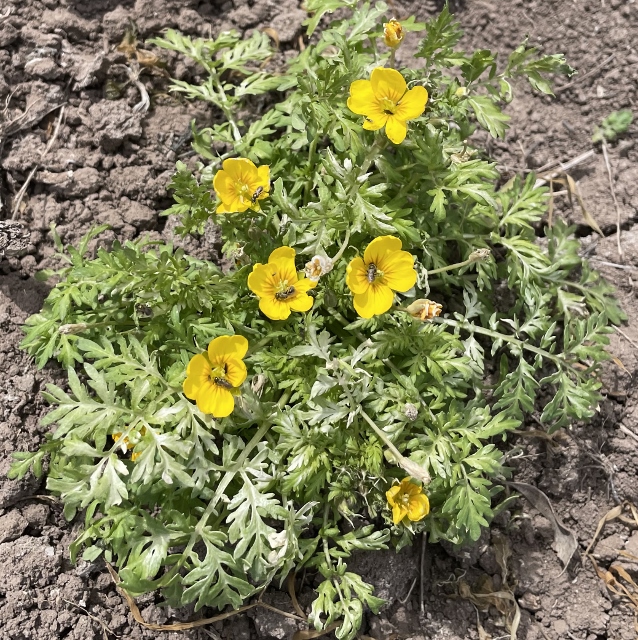
A couple of days later, I found clumps of one of my favorite spring flowers near the road at the farm field adjacent to our land. South Texas Sand Scorpionweed, Phacelia patuliflora. Not only that, a Western honeybee was visiting one of the blooms. Despite what appeared to be a set-back, our native plants will soon take center stage and the brutal February freeze week will be but a memory.
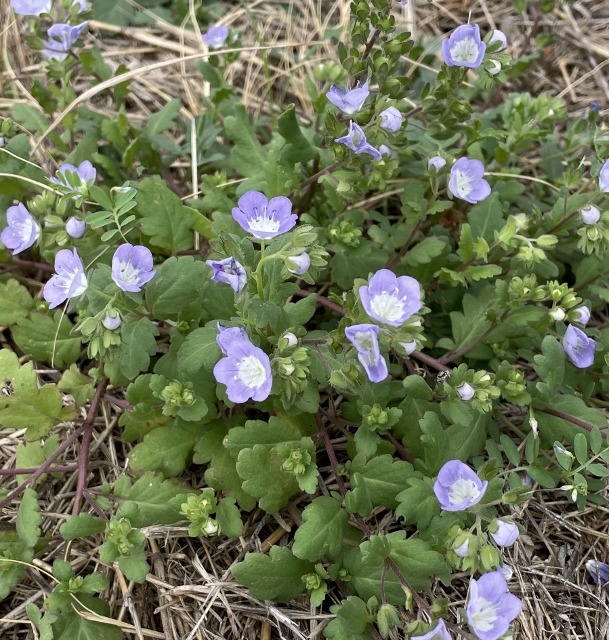
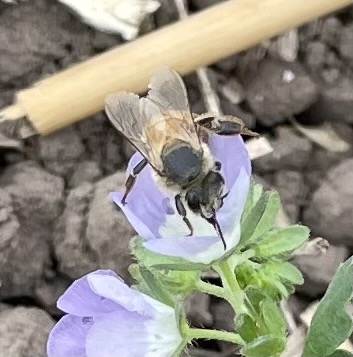
After the thrill of discovering all the native plant signs of life, a rather amazing thing happened early one overcast morning last week.
In the stillness of the grey morning, I heard the distant murmuring of a large group of birds. It was a sound I’d briefly heard the previous two mornings — a sound like a field full of turkeys gobbling in cadence, but not as gutteral. My thoughts the first day were of sandhill cranes; I had nothing to base that on so didn’t dwell on it. The third day, the drone of soft clucking began to increase; I looked up and saw a wave of birds undulating toward me. They veered off just before flying over my head and landed at the top of the recently plowed, neighboring field. I raced to the house, grabbed binoculars and camera and proceeded along the tractor path separating our properties.
I didn’t know how close I could get before the birds would take flight — well, not that close, let me tell you! There was no cover between the cranes and me. Although I barely crept along, would quietly stop at intervals and slowly lift the camera and long lens, the cranes must have an incredible sense of danger. I wasn’t able to get close enough for a decent shot before they swept off en masse. For those interested in collective bird nouns, those for cranes include: construction, dance, sedge, siege and swoop.
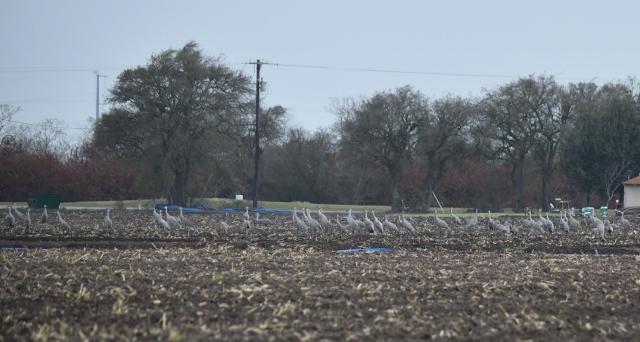
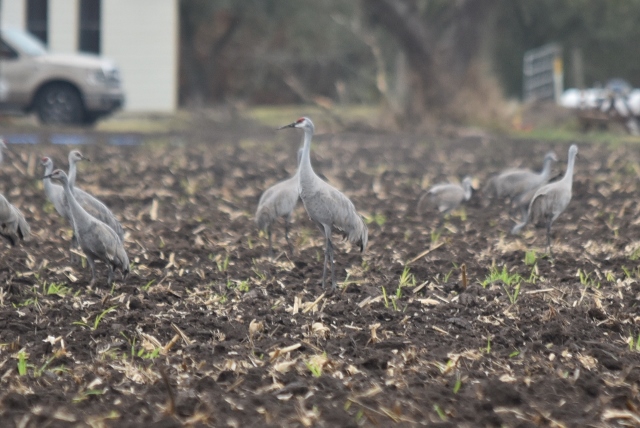
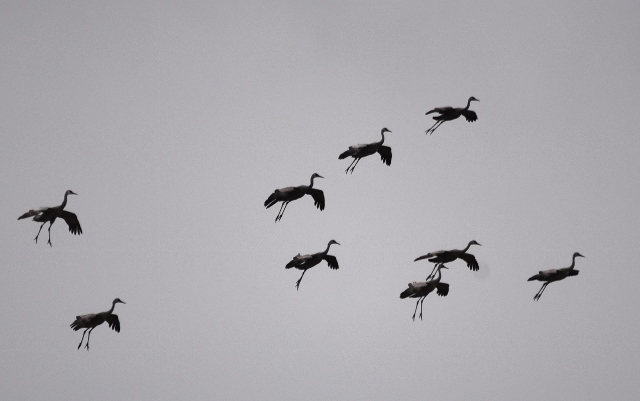
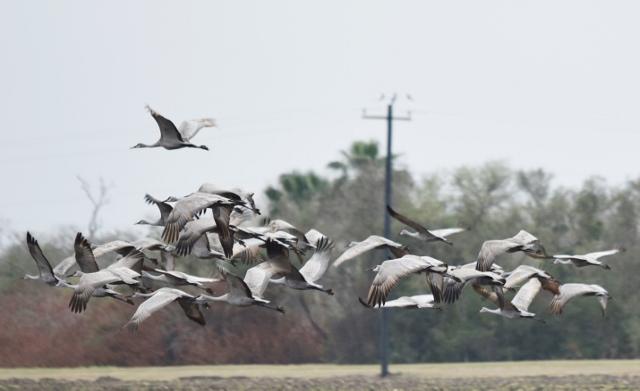
Another good omen, two days ago, I watched a juvenile red-winged black bird eat at the feeder tree outside our kitchen window. A red admiral butterfly landed in front of him. It was only the second red admiral I’ve seen on our property. Twenty-five red-winged blackbirds fed every morning at the feeder tree until three years ago. This is the first year to see any return. Both bird and butterfly went their separate ways, unharmed.
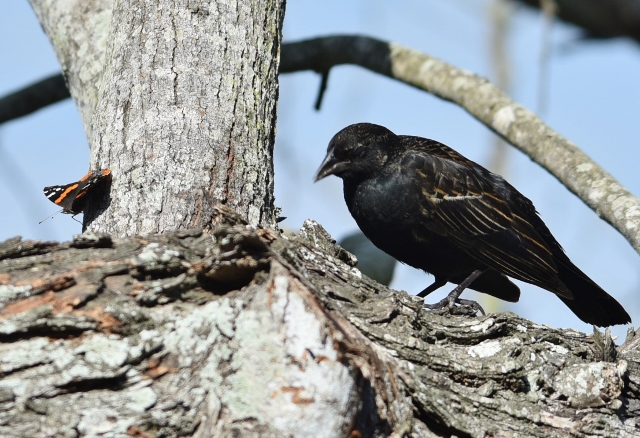
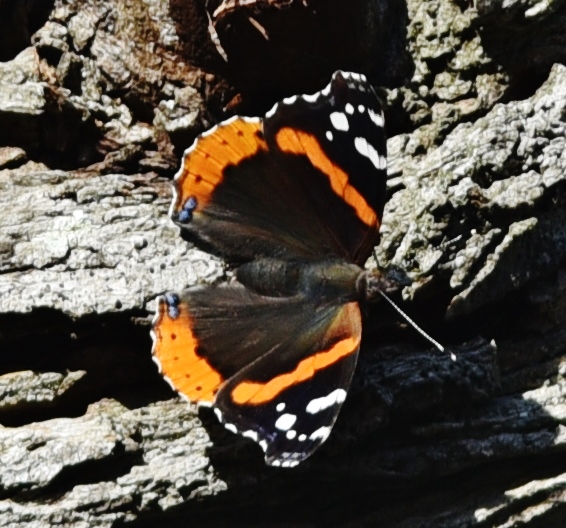
What looked to be the start of a bad year, recent surprises are showing me to anticipate an interesting and unique year.